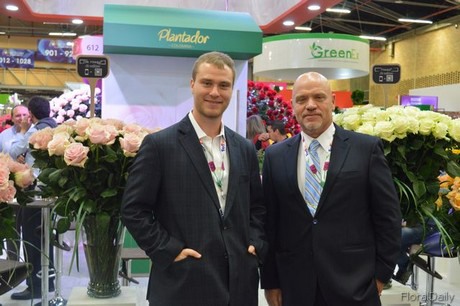
Aviram and his father Carlos Krell of Plantec Ecuador at the Plantador booth. Plantador represents Kordes, Interplant, Grandiflora, Delbard, Plant Research Overberg, and Scea Rosaplant in Colombia and Plantec represents them in the rest of South America.
Change in supply
Russia is a flower loving country and used to demand South American roses with long stems and large buds. However, when the economic crisis started in the latter half of 2014, this country shifted to shorter stems with smaller buds and South American roses were therefore no longer their sole option. According to Krell, due to the fall in demand for large South American roses in Russia, a majority of these roses found their way to the US market which had until then been almost exclusively interested in small roses. "Suddenly this market had access to bigger roses with larger stems and newer varieties that were rarely seen in the States before, with a reasonable increase in price."
Longer stems and larger buds for the US
This change in the type of supply affected the demand drastically. "American markets in all the different stages of commerce (i.e. wholesalers, supermarkets, retailers, event organizers, etc.) started seeing the advantages of larger roses replacing the popularity of smaller roses. These markets that had wanted roses of 50 cm with flower size of 4.5-5 cm as an absolute maximum were now insisting on stems of 60cm with rosebuds of 6cm. For example, some supermarket chains that until 2014 had been supplied with Escimo® roses began demanding Mondial®. While both were bred by Kordes, and have a similar color range, these varieties are easy to differentiate based on bud size and length. These larger characteristics have driven the markets to favor roses such as Mondial®."
Few varieties for Russia
Fortunately, the Russian market is recuperating since the end of 2016 and the beginning of 2017, but, according to Krell, it has not fully recovered the market size that was seen before the crisis of 2014. "Currently the core of the Russian market is centered around extremely few varieties such as Explorer®, Mondial®, and Pink Mondial®; not surprisingly all these are roses that range from 60 to 70 cm length stems and with rosebuds from 6 to 8 cm."
Success Mondial®
Due to these global changes, he notices that today’s Russian Markets are rarely asking for the largest of roses as in the past, but instead are interested mainly in roses of 60-70 cm and bud size of 6-8cm. According to Krell, this explains the high demand for roses such as Brighton (one of the main yellow planted colors in Ecuador and Colombia), Mondial, and Pink Mondial. "Over the last years, they became incredibly successful varieties within their respective colors."
For more information
Plantec Ecuador
Aviram Krell
Email: [email protected]
www.plantecuador.com
